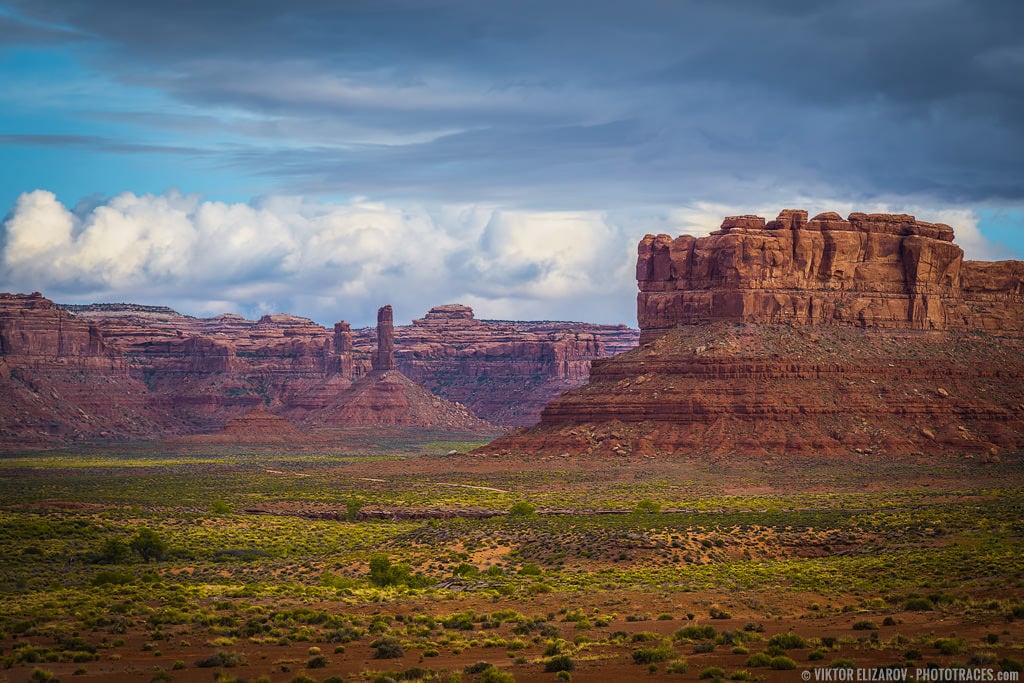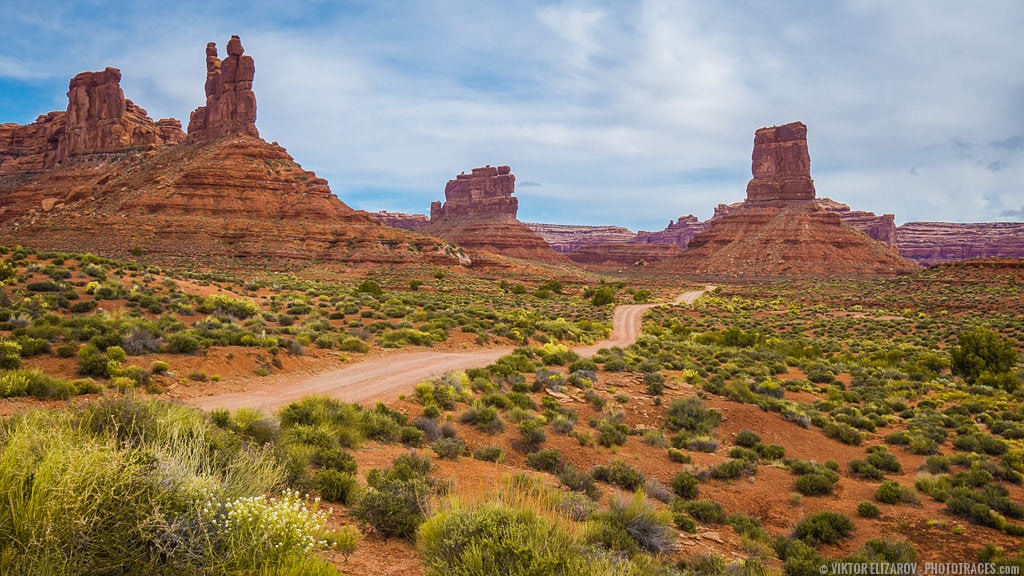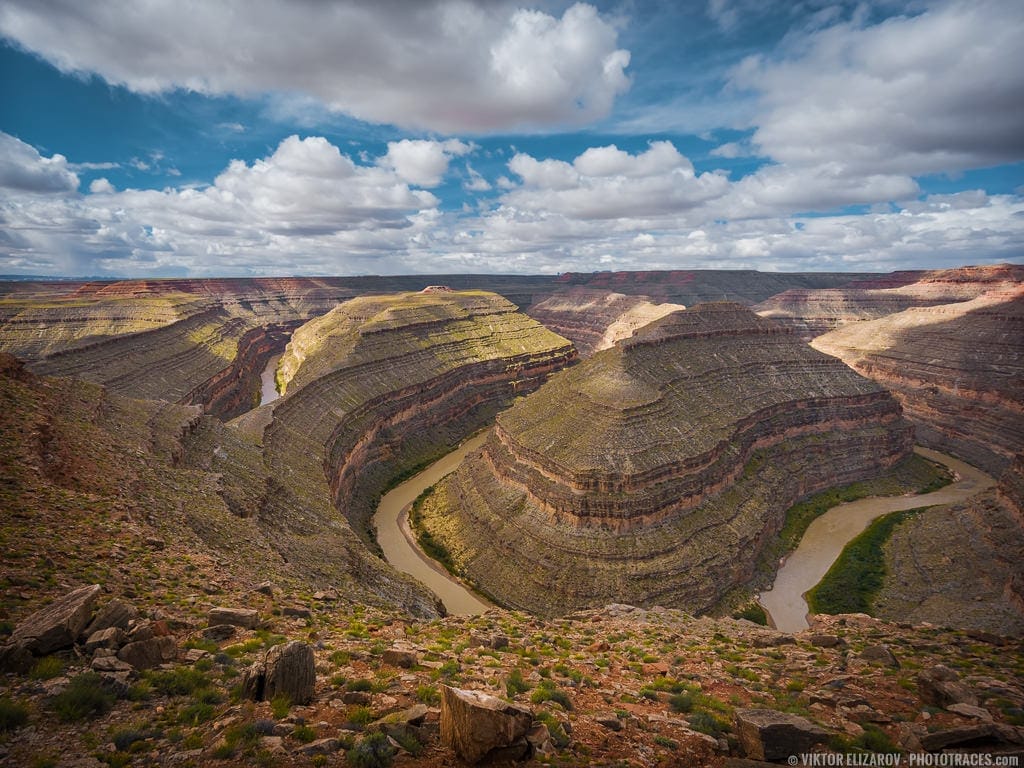Valley of the Gods was unplanned and, more or less, accidental discovery that happened a few years ago during one of my earlier trips to the southwest. I was aware of the area and even flagged it on the map, but I was absolutely certain that I would not have time to swing by the valley.

That year I had two big goals to accomplish in eastern Arizona: to swing by the elusive Canyon de Chelly and to visit the Monument Valley in Utah for the first time.
When I arrived at the Canyon de Chelly early in the morning, my plan was to dedicate an entire day to photographing the lesser-known National Monument. After sunset, the plan was to drive to the motel in Bluff to prepare for the next day’s trip to Monument Valley.
After hiking half the day in Canyon de Chelly and enjoying the perfect summer weather, the Canyon was hit by a sudden and very strong storm in the early evening. The wind was so powerful that I was afraid of flipping my rental SUV. I had no choice but to leave the area early and start driving toward Bluff.
Related: My Favorite California Landscape Locations
As I approached Bluff, I realized that the change in plans left me without any ideas for a sunset location. I needed to make a decision fast. It just so happened that the Valley of the Gods was the closest flagged location on my custom Google Map. So, without expecting much, I drove to the valley.

Much to my surprise, the Valley of the Gods became the most interesting discovery of my entire trip.
What is the Valley of the Gods?
The Valley of the Gods is a backcountry scenic area in southeast Utah. It is located south of the Bears Ears National Monument and east of Monument Valley.

It is famous for its scenic rock formations, which are similar to Monument Valley and are spread around a relatively small area of public land. It is managed by the Bureau of Land Management and, as a result, offers some advantages compared to other places located on Indian reservations.
Related: Utah Landscapes – Top Photography Locations
For example, both Monument Valley and Canyon de Chelly are located on the Navajo Nation land and visiting both parks comes with many tribal restrictions. The most significant restriction for adventurous travelers is that you cannot explore the area on your own; you must be accompanied by a Navajo guide.

The Valley of the Gods does not have such restrictions. Entrance into the valley is free. You do not need a permit to visit the Valley and you can explore the area on your own, any way you want.
Since only a tiny portion of tourists who come to Monument Valley is aware of the Valley of the Gods, it offers a sense of remoteness and solitude.

Valley of the Gods (Utah) Dirt Road
The only way to explore the Valley of the Gods is to take the dirt road that connects Highway 163 and Highway 261. It is a 17-mile clay and graded gravel road that is relatively flat and wide. It does not require a high clearance or 4×4 vehicle. You can drive it with any rental car.

But, like most clay roads in Utah, it becomes impassable when it is wet. It is prudent to stop at any Bureau of Land Management office to inquire about road conditions and the weather forecast.
You can enter the Valley of the Gods from either Highway 163 or Highway 261 and drive it clockwise or counterclockwise. I’ve driven both directions and do not see any advantages to one over the other.

Valley of the Gods Camping
You are allowed to camp in the Valley of the Gods; you do not need a permit. Camping is only permitted in previously impacted areas. Do not forget that it is dispersed camping without water or facilities, which means you must be prepared and fully self-sufficient.
Dogs are allowed but campfires are not.

Valley of the Gods Hiking
Hiking is permitted anywhere in the Valley of the Gods. The challenge with this freedom is that the valley does not have any established trails. You must create your own itinerary.
In my case, it was a series of short walks from the side of the road toward interesting mesas and buttes. Sometimes, I walked around the formations trying to find the best perspective for my photos.

Valley of the Gods Map
When I drove along the Valley of the Gods dirt road for the first time, I had no idea what to expect so I simply tried to enjoy the new experience. Only later did I discover that almost every mesa, butte, and cliff in the Valley of the Gods has its own name, such as Setting Hen Butte, Rooster Butte, Seven Sailors Butte, De Gaulle and His Troops, and Lady in the Bathtub.
Related: Arizona Landscape Photography – Top Locations
I returned to the valley once more to ensure I captured the most interesting landmarks. Later, I mapped them into Google Maps, which I have shared here to help you plan your trip to the valley.
Here is a map with the most interesting rock formations in the Valley of the Gods.
Places to See Around the Valley of the Gods
If you plan to make the Valley of the Gods part of your next travel itinerary, you should also make time to visit two other interesting spots nearby.
Moki Dugway
Moki Dugway is located a mile from the western entrance to the Valley of the Gods. It is three miles of 11% gravel switchbacks that climb the Cedar Mesa. It was originally part of an ore mining operation but now serves as a public mountain crossing.

From the top of the Moki Dugway, you will enjoy a breathtaking view of the Valley of the Gods and Monument Valley in the distance.
You can spot all the named mesas and buttes in the valley and see the winding dirt road you just traversed.

Goosenecks State Park
Goosenecks State Park is located nine miles from the western entrance to the Valley of the Gods. It is probably the smallest state park I ever visited.
Related: Big Sur Road Trip – Coastal Drive
The main attraction of the park is the overlook on two giant bends of the San Juan River. The scale of the view is amazing and unprecedented.

The visit to Goosenecks State Park will take an hour, at most, but it is a must-see destination.
Valley of the Gods | Final Thoughts
The Valley of the Gods in Utah is an impressive and unique landscape that should be explored by anyone looking for a truly captivating experience. Highlighted by its red sandstone buttes, mesas, and hoodoos, this region is one of the most stunning places in the Southwest. Whether you plan on camping, hiking, or simply taking in the views, the Valley of the Gods offers something for everyone.

